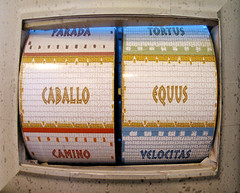
foto Alex Fuentes
Twice for #langchat we've polled the following question:
What activities prepare students for AP from the very beginning?
I confess, I probably wrote this question, maybe with some help from something similar being suggested as a topic. Certainly I've voted for it twice. But for whatever reason--perhaps teachers of lower levels don't think much about AP or the question was polled with others deemed more relevant--this topic has lost both times. So as usual, I'll take my opinion to the blog. Because I can.
I'm currently in my fourth year teaching AP. I know I've learned a lot from it, and I've gotten better at it, but my students are also improving considerably, mostly, I think, from what they get before my class, not from what they get from it. AP is a fourth-year class at my school. My first year, I had just 2 students, scoring 1 and 2. Second year, 6 students scoring one 3 and five 1's (ouch). That year I was so mad at the College Board I won't tell you what I wanted to do with them. Last year I hit some things really hard and actually, I ended up with my eight students scoring one 4, three 3's, two 2's, and two 1's (yay!). This year, I have such a stellar group of kids that I wouldn't be surprised if all six of them pass.
Now, in all seriousness, I hate the AP. I hate the test, and I hate the College Board, and I hate the idea. I can't stand that one three-hour exam thinks it can predict how proficient my students are and will be in college in Spanish. That student my first year that scored a 2, he was conversationally fluent, at least an Advanced Low speaker, after 3 years (he'd skipped Spanish 3) and the most motivated learner I have ever met. Of the two students who scored 1's last year, one is majoring in Middle School Spanish Education and the other is minoring in Spanish.
Really, that's how I feel about all standardized exams (thank you, Alfie Kohn). But the fact is, most of my students care about it. It is our only fourth-year option, and last year they voted on whether to keep it AP (in which they are required to take the exam) or to call it Spanish 4 (in which they'd have the option to take the test). But all but one voted for AP. They want the weighted grade points, and the AP Advantage study hall, and yes, they want the extra focused preparation for the exam. They want the bragging rights, and they want the college credit. So, I'm about pleasing the students, and here we are again.
After four years of watching students struggle and succeed in their fourth-year AP class, here are my requests for you, the elementary teachers (which I also am) through middle school, Spanish 1, 2, and 3 teachers.
- Please, please, PLEASE feed them ALL KINDS of authentic audio.
This is my #1 because it's my #1 problem with my students. They get to me (in Spanish 3) and can't understand anything but learner language. The majority of audio on the AP is not learner language. It's stuff like BBC Mundo and Radio ONU (which I couldn't understand until, say, 10 years into my journey). More importantly, the majority of audio in life is not learner language.
The common mistake is to think that novices cannot understand authentic media. The truth is that the difficulty is in the question and not in the source. If you're asking them to hear the word cinco that's a different question than if you're asking them to hear the word aprovechándonos. - Interact with vocabulary in real contexts.
Asking students "what is the word for black? Good! Red? Great!" does almost *nothing* for their language acquisition. Trust me, from day one a novice learner can understand this question:
¿De qué colores es un oso panda? (2)
Context is everything. My current AP students have not had a vocab quiz in four years and their vocabulary is incredible. Yesterday in our novel they were accurately identifying words like solía and lechuza. One of my Spanish 3 students actually asked for vocab quizzes the other day and we had to have a talk about how cramming does not create long-term memory. This is connected with the issue of authentic media - get students listening to and reading real materials and the vocabulary will just be there. I promise. - Ask questions that require critical thinking.
Critical thinking is a life skill. Prepare your students for life by asking them real questions that make a difference. Stop asking 'what' and start asking 'why' and 'how.' To me, the true test of a critical thinking question is if there's no clear-cut answer. Instead of stopping with "what foods do you like?" ask "is a guinea pig food? why or why not? would you try it?" (In Ecuador, guinea pig - 'cuy' or as my dad likes to call it, 'barbecuy' - is a delicacy.) - Do speaking assessments. GET THEM TALKING.
My current Spanish 3 students tell me that last year they had exactly 1 speaking assessment. Now, kids like to complain about teachers, but if it's anywhere close to the truth, it's far too few. They're now facing two speaking assessments each in every unit for sixteen in all and they're dying. They hate it, except for my one who's aptitude leans toward speaking and away from writing.
The AP has a wicked guided conversation activity in which someone says something, then there's a beep, and the student has 20 seconds to think up and say what the test says they need to do. That's repeated about five times and that's the interpersonal speaking section. It's stressful and intense and unrealistic but there you have it. My current AP students are so used to talking back and forth in class that this year they were able to do this for practice without much anxiety much sooner than the students I had last year. Keep students talking -for the AP and for life. - Teach and require idiomatic expressions.
It's a sad fact about general proficiency guidelines and about the AP that the difference between one level and the next can come down to one single phrase - an idiomatic one. Three years ago the one student who passed said she went in determined to use the phrase "vale la pena." Honestly, she was the most proficient student in the class but I wouldn't be surprised if it made the difference between 2 and 3 for her. Keep an idiomatic expression on the wall, once a week or every two weeks. Reward students when they use them. Do an activity that requires a particular one. Point them out in authentic texts. Realize, and help students realize, that language is idiomatic. - Do assessments that require extrapolating and synthesizing main points from multiple sources.
A couple of years ago I did a KWLA presentation called Prompts with Power. It was about finding authentic sources and asking students to answer a question, orally or written, based on the sources. Teach students to draw their own conclusions after comparing and contrasting two other opinions. Or three. Similar or different, it doesn't matter, but it's a life skill -and an important one on the AP- to be able to look critically at what other people think and use those opinions to develop an informed personal one.
Perhaps it's good I had to write this here and not on #langchat - this is certainly more than I could have explained in snippets of 140 characters. Thanks for putting up with it.



















 Some variations:
Some variations:




